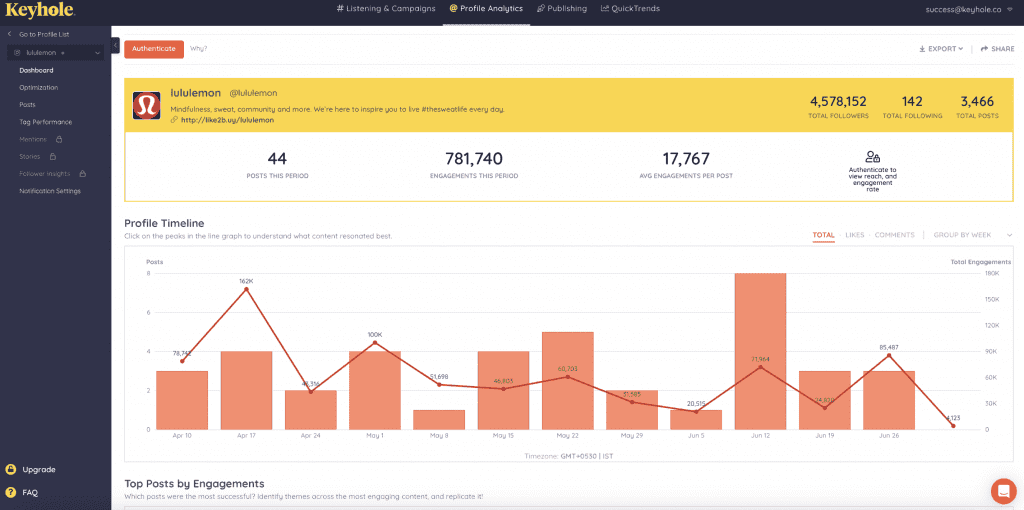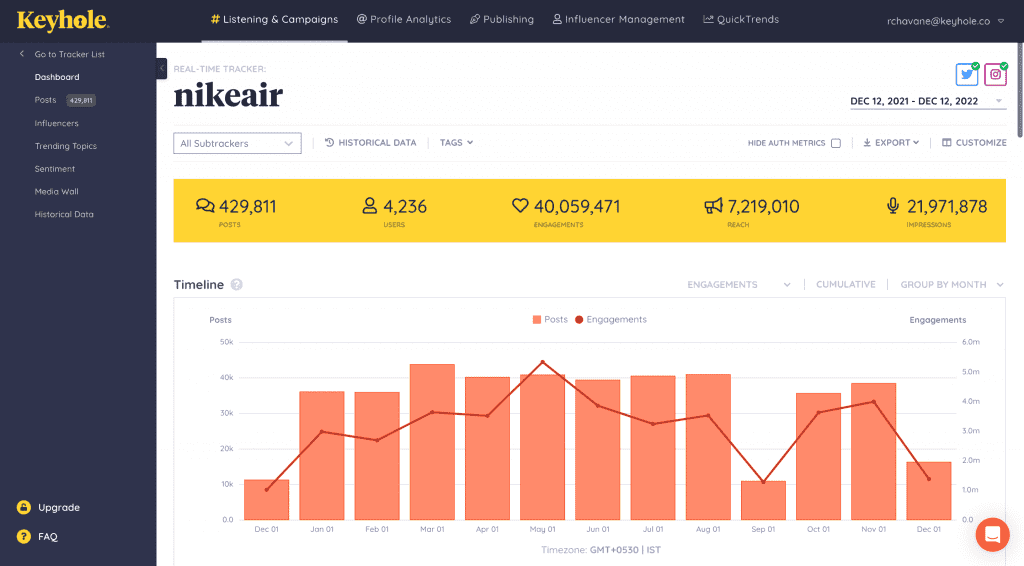Making a positive difference in the world is no simple task – but a carefully thought-out non-profit social media strategy can help you accelerate the tides of change.
Social media can be a vital tool to get your message across, create discussion about the issues you tackle and, ultimately, raise money for your cause.
This has been proven time and again in recent years, as NGOs have shown off their creativity and found new ways to interact with the online world.
This has led to some inspiring campaigns. From the heartwarming Love Has No Labels video, which has reached 60M views and was shared by Michelle Obama, to the engaging, Girls Who Code digital experience, which encouraged girls to code a video game character in defiance of a lack of female representation across the industry.
Social media has been used to capture imaginations and start conversations for a whole range of causes.
So, looking for a place to get started and make your own impactful campaigns?
This blog has you covered, as we’ll be running through 10 actionable steps that every charitable organization should be doing when taking their campaigns to the digital world. Let’s dive in!
Table of Contents
- 1. Identify target audience
- 2. Align goals with the organization’s mission and vision
- 3. Create your dream social media team
- 4. Develop content strategy
- 5. Create social media budget plan
- 6. Find the best platform
- 7. Implement social media tactics
- 8. Monitor and evaluate performance
- 9. Build relationships with supporters
- 10. Leverage user generated content
- Wrapping up
- Frequently Asked Questions
1. Identify target audience
Creating an effective non-profit social media strategy begins with a deep understanding of your target audience.
To achieve this, the first step is to conduct comprehensive market research. Whether you do this yourself or through an agency, it will involve analyzing data from various sources (such as surveys, social media, and customer feedback).
From here you can develop an ‘audience persona’ of your typical follower’s interests, motivations, and types of online activity – thus allowing you to create more personalized content.
Conducting prospect research for nonprofits and identifying your target audience can be an arduous process, but it will pave the way for stronger connections that deliver on expectations.
Another great way to create an effective social media strategy that will increase audience interaction is by donor segmentation. This strategy involves dividing your donors into distinct groups, so you can create a targeted and resonant communication style. By creating content that aligns closely with their donors’ values and concerns, nonprofits can build stronger emotional connections, leading to increased engagement and higher donation rates.
2. Align goals with the organization’s mission and vision
Aligning your social media goals with your nonprofit’s mission and vision is essential for a cohesive and impactful strategy.
Let’s examine a case study to illustrate this – WWF, the world’s largest conservation organization, follows 4 core values in all of the work that they do:
- Courage – For example, raising topics that are the most important to speak about (rather than those that will simply drive clicks).
- Integrity – For example, only creating content that is backed up by factual data, and linking to sources for full transparency.
- Respect – For example, always seeking the consent of the people and communities whose stories you are telling, and doing so in an unbiased way.
- Collaboration – For example, inviting like minded people and organizations to speak alongside you, and striving to support other groups in your field.
Before launching your non-profit social media strategy, start by revisiting your organization’s core values, purpose, and long-term objectives. Identify how social media can help advance these goals, whether it’s raising awareness, increasing donations, fostering community engagement, or appealing to influential people in an open letter.
Do this successfully – and you will guarantee that your efforts are purposeful and directed towards achieving meaningful outcomes.
Building a capable and passionate social media team is key to executing an effective non-profit social media strategy.
Start by identifying the specific roles and responsibilities needed, such as content creation, community management, analytics, and strategy. Make sure to look for individuals with experience in social media marketing, content creation, and knowledge of your nonprofit’s cause.
Consider both internal staff and external experts or volunteers who can contribute their skills and perspectives. Dedicate time to organizing volunteer opportunities specifically for social media.
Foster a collaborative and creative environment, provide training and resources, and empower your team to bring your social media strategy to life.
Once you’re up and running, your social media dream team can leverage their expertise and passion to maximize the impact of your online presence and connect with your audience on a deeper level.
4. Develop content strategy
A well-crafted content strategy is essential for engaging with your nonprofit’s target audience.
First off, you should determine the themes, messaging, and storytelling techniques that will effectively convey your organization’s impact. Digital asset management for nonprofits can be invaluable in this process, streamlining the organization and distribution of varied content tailored to different audiences.
You may find that younger audiences prefer regular short-form content with clearly defined calls-to-action, whereas older audiences engage better with long-form content.

Make sure to also tailor your content to each social media platform and leverage various formats like videos, images, and compelling captions to captivate your audience and inspire action. Whatever approach you go for, creating a content calendar with Keyhole can make sure you have consistency and help you plan for timely campaigns, events, and fundraising initiatives.
Allocating a budget for your non-profit’s social media efforts is crucial for planning ahead and delivering a consistent content schedule.
You’ll need to identify the resources required for content creation, platform advertising, social media management tools, and analytics. That’s not to mention additional fees for things like pay-per-click (PPC) marketing campaigns, which could amplify your reach and drive engagement at a faster rate.
Additionally, make sure to allocate funds for staff training, workshops, and hiring external expertise when needed. After all, developing a content plan without the people to drive it would be like investing in a car that has no wheels!
Ultimately, you’ll need to continuously evaluate and adjust your budget plan based on the performance and ROI of your social media activities. This balance can take a while to perfect, so it’s best to play it safe and avoid blowing through your budget at an early stage.
To help manage this, use resource planning software to connect to your customer service and accounting ledger data. Cloud ERP solutions can be really helpful when it comes to allocating future social media budgets — as it keeps all the essential information and analytics in one place. You’ll have peace of mind knowing that you’re making the best decisions and spending your money wisely!
6. Find the best platform
When it comes to selecting a social media platform, there’s no single ‘correct’ answer.
Popular sites such as Facebook, Instagram, Twitter, and YouTube are common choices for a non-profit social media strategy, but you should also consider more niche platforms relevant to your cause.
- For example, a young audience might respond better to a TikTok campaign that prioritizes engagement, such as quizzes or community action.
- On the other hand, an older audience may prefer a LinkedIn campaign that focuses on shareable educational resources.
You should conduct research to understand which platforms your audience actively uses and where your content will have the most impact. Then, try to tailor your content on each platform to the audience you think uses it, all the while maintaining a similar visual brand and style.

You can also use Keyhole’s social media analytics feature and gauge which platform works best for you. See which particular posts give you most reach and engagement, what’s your best time to post, how’s your competitors performing compared to you, and more.
Finally, make sure to set up your account as a non-profit on the platform you choose. This could unlock new features such as integrated donation buttons, charitable giving tools, or fundraiser activities. Plus, it’ll enhance your brand’s credibility with users and potential partner organizations.
Social media is a powerful tool for connecting with others, but you have to play the same game as everyone else. That means you must develop a set of social media guideline policies for everyone involved with your campaign, such as:
- A clear directory of who works on your team, their roles, and contact information.
- Briefings on relevant copyright and privacy laws.
- Guidance on how your team members (whether staff or volunteers) should act on their personal accounts.
- A backup communications plan in case of an emergency.
8. Monitor and evaluate performance
Keyhole empowers non-profit organizations to implement effective social media tactics by providing real-time data and insights. With Keyhole, you can track hashtags, keywords, and mentions related to your cause, allowing you to identify trending topics and conversations. This information helps you create engaging and timely content, join relevant discussions, and amplify your reach.

Keyhole’s comprehensive analytics also enable you to measure the impact of your tactics, such as tracking post performance and evaluating campaign success. This data-driven approach makes sure that your nonprofit’s social media tactics are strategic, targeted, and effective. Plus, it’ll be much easier to share performance updates with stakeholders and measure campaign ROI.
For a truly comprehensive data solution, make sure you contextualize your social media performance amongst other data points by using tools. As it collects and manages data from across your entire organization, it means you get a better understanding of how your social media efforts are impacting your overall goals.
9. Build relationships with supporters
A highly-engaged base of supporters is the single best way to spread the word about your cause.
Luckily, you have several methods available for accelerating this process:
- Using hashtags, contests, or campaigns to motivate user participation and content creation.
- Engaging with your audience through responding to comments, messages, and mentions.
- Creating highly-shareable content that is both meaningful and educational (a little bit of humor can go a long way).
Doing this will humanize your campaigns and remind your audience of your goals and values, prompting them to stand up and make a difference themselves.
10. Leverage user generated content
Finally, you should showcase user-generated content on your social media channels to demonstrate the impact and diversity of your supporters.
Encourage supporters to share their stories, experiences, and testimonials related to your cause. Campaigns like this can be incredibly successful, for example, the viral 2014 ALS Ice Bucket Challenge continues to have an impact on research and funding even now.
This strategy not only increases engagement but also fosters a sense of connection among your audience. Of course, make sure there aren’t any risks attached to the activity and give credit to the creators of user-generated content if you use it in your campaigns.
Wrapping up
Adopting a focused social media strategy is essential if your charitable organization is to cut through the noise and make an impact in digital spaces.
If you’re a social media marketer looking to get started – the good news is that you’ve never been so spoiled for choice with the tools available to you. Emerging technologies such as AI and data analytics can streamline operations in your nonprofit.
Keyhole has a wide suite of products for amplifying social media impact and driving meaningful change in the digital landscape. Get started with your trial!
Related Articles:
5 Underrated TikTok Marketing Tips You Need To Try
How To Create Monthly Instagram Marketing Strategy Template
Frequently Asked Questions
Conduct comprehensive market research, analyze data from surveys and social media, and create an "audience persona" based on interests, motivations, and online activity to develop personalized content.
Consider popular platforms like Facebook, Instagram, Twitter, and YouTube, but also explore niche platforms relevant to your cause. Research where your target audience is active and tailor your content accordingly to maximize impact and engagement.
Keyhole provides real-time data and insights, tracking hashtags, keywords, and mentions to identify trending topics and measure the impact of tactics. Helping your nonprofit to be able to easily plan social media campaigns and monitor performance across different platforms.